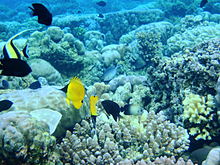Bunaken National Park
The remaining 3% of the park is terrestrial, including the five islands of Bunaken, Manado Tua, Mantehage, Nain, and Siladen.
Manado Tua is an inactive volcano formed in a classical cone shape and rising over 600 m above sea level, the highest elevation in the park.
At the same time, the dominant seagrasses, in particular in the islands of Montehage and Nain, are Thalassia hemprichii, Enhallus acoroides, and Thalassodendron ciliatum.
[3] About 2000 species of fish live in the park waters, including the emperor angelfish, Almaco jack, spotted seahorse, bluestripe snapper, pinkish basslet, and two-lined monocle bream.
[5][6] Mollusks include the giant clam, horned helmet shells, and chambered nautilus; ascidians are also present.
Among the animal species that live on the land and the beaches are the Celebes crested macaque, Timor Deer, and Sulawesi bear cuscus.
Most locals work as fishermen or farmers cultivating coconut, sweet potato, banana or seaweed for export, while a small number are employed in tourism as dive guides, boat operators, and cottage staff.
[1] The World Wildlife Fund provides conservation support in the National Park as part of the Sulu Sulawesi Marine Eco-region Action Plan.

